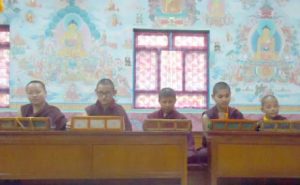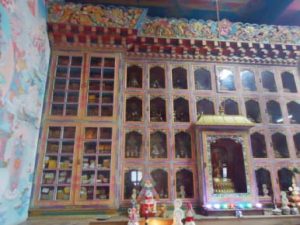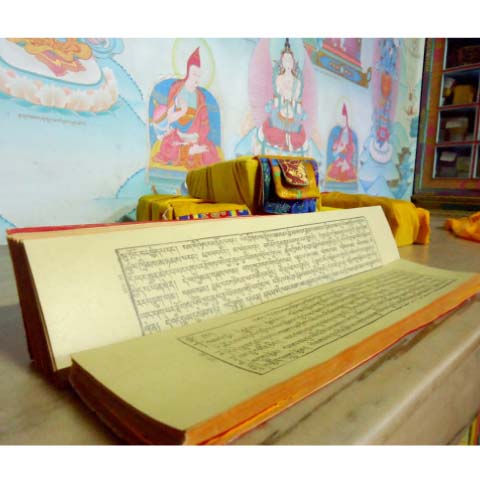
The Kagyur (Tibetan: “words, speeches;” a collection of canonic works attributed to Buddha) and Tengyur (Tibetan: “translation of teachings;” Tibetan collection of commentaries on Buddhist teachings) are the combined legacy of all Buddhists who have lived from the time of the Buddha until the present. Also known as the Canon, they are two voluminous collections containing the key sutras (teaching discourse made by the Buddha or his students) of this world religion.
Although parts of the Canon have survived in the ancient Mandarin and Pali versions, the Tibetan version is the most complete to date. The Kagyur contains 1,108 entries (a sutra is considered as one entry), while the Tengyur contains 3,459 entries of different lengths. If 50 monks were to recite different parts individually for eight hours a day, it will take around 30 days to read through the entire collection.

Buddhism in the modern times
In my opinion, Buddhist wisdom is smothered in cultural and social stereotypes nowadays. It is a shame when Buddhism is merely associated with lighting incense, burning paper money during All Souls Day, or wearing an amulet for luck in the New Year.
There is a distinct rawness and pragmatism in the intelligence of Buddhism. It gives the earnest reader so-called ‘wisdom’ – to shrink his or her own egotistical ignorance. The Kagyur is one such work that is dedicated to tackling that ignorance.
Inside the Kagyur
In essence, the Kagyur contains stories and advice against ignorance, and its manifestations such as pride, anger, desire and envy. This is explained via parables, anecdotes and sermons on social ethics, discipline and metaphysics.
Context is vital in the Kagyur. A teaching of the Buddha to his millionaire disciple, Anathapindika, will not make sense to the blacksmith disciple, Cunda. Buddhism is sometimes known as 84000, because it contains 84,000 teachings (sometimes contradictory) to solve the 84,000 problems we suffer from.
Below are a few sampler sutras found inside the Kagyur.
Ignorance may sound flamboyant, but I assure you it is not. Take the romantic couple as an example. During courtship, it is rare for one party to perceive the ugly qualities of the other, although those qualities have always been there. That is because one has been swept off one’s feet. Similarly, we know that the moment we are born, we will undergo aging. Yet, we envy a child’s youth because our aging bodies give us problems. We are swept off our feet by the ‘illusion of permanence’ of the child’s youth.
That is ignorance. The Sutra on Impermanence (TOH: 309, translated) discusses this, and applies it to other universal human conditions such as life-death, health-sickness and prosperity-decline.
On sensual desires
Buddhism is attractive to a serial flirt like me because the Kagyur does not position this topic around ‘sin’ and ‘punishment.’ Rather, it lays out the practical sufferings stemming from obsessive desires.
This was the recurring theme as I read The Sutra on the Questions of King Udayana of Vatsa (TOH 73: untranslated). Brainwashed by his jealous consort that his daughter had acted immorally, the king was about to behead the beautiful Princess Syama, until the Buddha arrived. Filled with remorse for being under the spell of attachment, King Udayana requested the Buddha to teach on the faults of sensual desires.

On contentment and wealth
In the Sutra Requested by Suraja (TOH 71, untranslated), Suraja, a contented monk, picked up an ancient golden bell on the road that is ‘worth the world.’ He told himself that he will give this to the poorest in the city of Sravasti – King Prasenajit! So, the King realized that his discontentment amid his wealth is making him feel poor.
Being born in Binondo, I initially had huge reservations regarding the Buddhist idea of ‘satisfaction and contentment.’ I argued, “How do I achieve something if I am fully contented and stop working?” If one is willing to search and practice enough, the theory will slowly reveal itself.
The Buddha’s enlightenment: The inside story
This part is directed more toward Buddhists and ‘result-oriented’ spiritual practitioners. The official account was that at the age of 29, Siddhartha Gautama renounced the princely life and became a monk. For six years, he practiced meditation until he realized enlightenment to become the Buddha.
Sounds easy. However, in the Sutra of the Questions of an Old Lady (TOH: 171, translated), we get a ‘juicier’ insider’s account.
The Buddha’s attendant, Ananda, could not contain his surprise when the Buddha expounded the most profound teaching to a poor 120-year-old lady they just met on the street. He inquired why an old lady was receptive to such profound lesson which was only reserved for veteran monks.
The Buddha replied that in his past 500 former lifetimes, he had renounced secular life and left home – and she was his mother! In all those 500 lives, he studied under different teachers, while she always rejoiced at her son’s action. She also aspired that one day, she might learn from the wisdom he gains (which she finally achieved in this meeting).
Now we know a little more behind the serenity of a Buddha statue.

A brief history
Why is the Kagyur unfamiliar to most of us? I believe this is because there is a “lack of demand” for such works. If you look at history, the ancient Tibetans generated a strong demand for it.
The Canon was first compiled in the late eighth century in Tibet, with Indian panditas (Sanskrit: scholars) and Sanskrit scriptures being ‘imported’ from India. From Sanskrit, the sutras were translated into Tibetan across the few centuries by hundreds of collaborating Indian panditas and Tibetan lotsawas (Tibetan: translators). Behind this grand project was the unparalleled sponsorship of Tibetan King Trisong Detsen (755-794 CE), who played a pivotal role in introducing Buddhism to Tibet and the establishment of the Nyingma or ancient school of Tibetan Buddhism.
Buddhism in Tibet flourished until 836 CE, when the Tibetan Emperor Relpachen was assassinated by his brother Langdarma. Upon assumption of the throne, the new 42nd emperor began a drastic repression of Buddhism throughout Tibet. Buddhist scriptures were destroyed, monasteries closed down and monks forced to disrobe.
Three great holders of the lineage of Shankarakshita (renowned eighth-century Indian Buddhist Brahmin), however, managed to escape to the most northern region of Tibet, and thus saw the revival of Tibetan monasticism. Soon, others arrived from western Tibet and the community multiplied, with masters later returning to central Tibet to revive Buddhism there.
By the end of the 12th century, while the Canon already saw several versions springing up in Tibet, India was occupied by Muslim invaders. The famed Buddhist University Nalanda was burned to the ground and most of the Sanskrit collection was destroyed.
84000: From ancient to modern
As of today, 95 percent of the Canon remains untranslated from Tibetan. That means most of the stories remain in hundreds of volumes of pechas (Tibetan-style book) wrapped in fine cloths, and is only accessible to Tibetan readers.
‘84000:Translating the Words of the Buddha’ is a 100-year project to translate the Canon from Tibetan into English, made available for free (copyright under Creative Commons) online. The project is aptly named 84000, as I have described above. At present, the online collection of translated sutras is steadily growing.
Conclusion
In our fast westernizing society, the Canon is what it is to us – unknown and largely irrelevant. Yet, it continues to serve as a practical guide to many readers in the Himalayan regions. The handful of sutras translated into other major languages have inspired many more people.
As more people around the world embrace the tenets of Buddhism, such unprecedented projects as the 84000 are sprouting. Like the vision of King Trisong Detsen and the hundreds of Indian panditas of the past, its accessibility and ability to enlighten another generation should be top priority.
To read translated sutras in English, visit the Reading Room at www.84000.co. ‘TOH’ is the entry number of a sutra.





